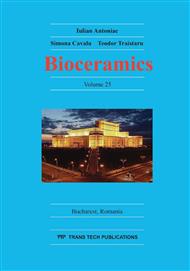[1]
Delloye C, Cnochaert C, Corbu N., Bone substitutes in 2003, an overview. ActaOrthopBelgica 69: 1–8, (2003).
Google Scholar
[2]
Gouin F, Cappeli M., Aplications cliniques des céramiques phospho-calciques: Biomateriaux de substitution de l'oset du cartilage-. Cahiers d'einseignement de la SOFCOT. Expansion ScientifiqueFrancaise, (1996).
Google Scholar
[3]
Delecrin J, Takahasi S, Gouin F, Camps C, Passuti N., A synthetic porous ceramic as a bone graft substitute in the surgical management of scoliosis. Spine 25: 563–569, (2000).
DOI: 10.1097/00007632-200003010-00006
Google Scholar
[4]
Augereau B., Kysteanevrysmal. Tumeur set dystrophies benignes. In: Tomeno B, Forest M (eds) Les tumeur sosseuses de l'appareil locomoteur. Laboratoires UNICET, Paris, (1993).
Google Scholar
[5]
CERAFORM®: Technical description in Les substitutes osseux en 2005, surl'egide GESTO, p.44, (2005).
Google Scholar
[6]
Schwartz C, Lecestre P, Fraysinet P, Liss P., Bone Substitutes, Eur.J. OrthopSurgTraum. 9(3): 161–165 , (1999).
DOI: 10.1007/bf00542583
Google Scholar
[7]
Botez P., Sirbu P., Simion L., Munteanu F., Antoniac I., Aplication of a biphasic macroporous synthetic bone substitutes CERAFORM®: clinical and histological results", Eur.J. OrthopSurgTrauma., 19 : 387-395, (2009).
DOI: 10.1007/s00590-009-0445-7
Google Scholar
[8]
Botez P, Petcu I., Analyse des applications chez l'homme d'un substitute osseux a base de céramique biphasique (CERAFORM). Étude prospective préliminaire, 8e Congres de l'AOLF, Bucharest, (2002).
Google Scholar
[9]
Daculsi G, Passuti N., Effect of the macro porosity for osseous substitution of calcium phosphate ceramics, Biomater 11: 86–88, (1990).
Google Scholar
[10]
Frayssinet P, Trouillet JL, Rouquet N, Autefage A, Delga C et al., Calcium phosphate porous ceramics osseointegration: the importance of a good definition of material specifications. Rev ChirOrthop 79, (1993).
DOI: 10.1016/0142-9612(93)90144-q
Google Scholar
[11]
Yuan H, Kurashina K, De Brujin JD, Li Y, De Groot K, Zhang X (1999) A preliminary study on osteoinduction of two kinds of calcium phosphate ceramics. Biomaterials 20: 1799–1806.
DOI: 10.1016/s0142-9612(99)00075-7
Google Scholar
[12]
Van Blitterswijk CA, Grote LL, Kuijpers W, DaemsWTh, De Grout K., Macrospore tissue ingrowths: a quantitative and qualitative study on hydroxyapatite ceramics. Biomateriaux 7: 137–143 , (1986).
DOI: 10.1016/0142-9612(86)90071-2
Google Scholar
[13]
Gourin F, Delécrin F, Passuti N, Touchait N, Poirier P, Bain JV, Comblement osseux par céramique phosphocalcique biphasée macroporeuse. A propos 23 cas., Revue Chir. Orthop. 81: 59–65, (1995).
Google Scholar
[14]
Malard O, Bouler JM, Guicheux J, Heymann D, Pillet P, Coquard C, Daculsi G., Influence of biphasic calcium phosphate granulometry on bone ingrowth, ceramic resorbtion and inflamatory reactions. J Biomed Mater Res 46(1): 103–111, (1999).
DOI: 10.1002/(sici)1097-4636(199907)46:1<103::aid-jbm12>3.0.co;2-z
Google Scholar
[15]
Gautier O, Bouler JM, Aguado E, Legeros RZ, Pilet P, Daculsi G., Elaboration conditions influence physicochemical properties and in vivo bioactivity of macroporous biphasic ceramics. J Mater Sci Mater Med 10(4): 199–204, (1999).
DOI: 10.1023/a:1008949910440
Google Scholar
[16]
Daculsi G, Passuti N, Martin S, Le Nihouanen IC, Brulliard V, Delécrin I, A comparative study of bioactive calcium phosphate ceramics after implantation in cancellous bone in the dog. Rev ChirOrthop 75: 65–71, (1989).
Google Scholar
[17]
Saito M, Shimizu H, Beppu M, Takagi M., The role of ß-tricalcium phosphate in vascularized periosteum. J OrthopSci 5: 275–282, (2000).
DOI: 10.1007/s007760050163
Google Scholar
[18]
Laurie SWS, Kaban LB, Mulliken LB, Murray IE, Donor-site morbidity after harvesting rib and iliac bone. PlastReconstrSurg 73: 933–938, (1984).
DOI: 10.1097/00006534-198406000-00014
Google Scholar
[19]
Summers BN, Eisenstein SM, Donor site pain from the ilium: A complication of lumbar spine fusion. J Bone Joint Surg 71-B: 677–679, (1989).
DOI: 10.1302/0301-620x.71b4.2768321
Google Scholar
[20]
Nery EB, LeGeros RZ, Lynch ZL, Lee K., Tissue response to biphasic calcium phosphate ceramic with different ratios of HAIBTCP in periodontal osseous defects. J Periodont 63: 729–735, (1992).
DOI: 10.1902/jop.1992.63.9.729
Google Scholar
[21]
Khan Y, Yaszemski MJ, Antonios GM, Laurencin C, Tissue engineering of bone: material and matrix considerations. J Bone J Surg Am 90: 36–42, (2008).
DOI: 10.2106/jbjs.g.01260
Google Scholar
[22]
D. Allison, A. Lindberg, B. Samimi, R. Mirzayan, L. Merendez, A Comparison of mineral bone graft substitutes for bone defects", US Oncology & Hematology.
Google Scholar
[23]
Gianouddis PV, Dinopoulos H, Tsiridis E (2005) Bone substitutes: an update. Injury 36 (Suppl 3): S20–S27.
DOI: 10.1016/j.injury.2005.07.029
Google Scholar
[24]
G. El-Adl, M. Mostafa, A. Enan, M. Ashraf, Biphasic ceramic bone substitute mixed with autogenous bone marrow in the treatment of cavitary benign bone lesions", ActaOrthop. Belg., 2009, 75, 110-118.
Google Scholar


